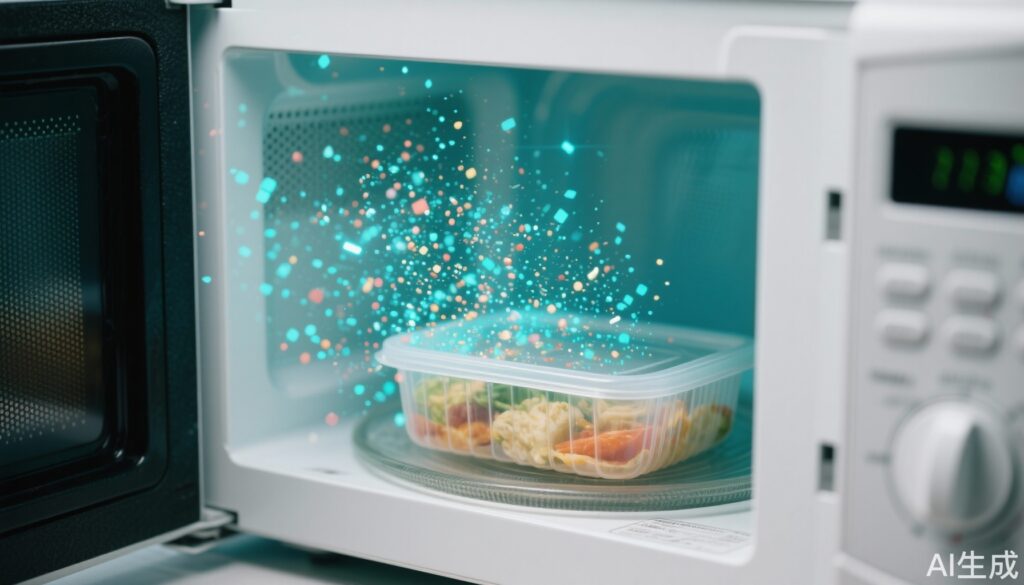Introduction
In our fast-paced world, convenience often shapes how we prepare and consume food. Microwaving food in plastic containers has become a common practice due to its speed and ease. However, recent scientific evidence challenges the safety of this habit. A groundbreaking study conducted by researchers at the University of Nebraska–Lincoln and published in the journal Environmental Science & Technology reveals that microwaving certain plastic containers can release staggering quantities of microplastics and nanoplastics into the food we eat. These plastic particles are invisible to the naked eye yet potentially harmful to human health.
This article delves into the emerging data on plastic particle release during microwave heating, their toxic effects observed in laboratory settings, factors influencing plastic degradation, and the implications for vulnerable populations such as infants and young children. We also discuss practical guidelines to minimize exposure to microplastics from plastic containers.
What the Data Tell Us: Microplastic Release from Plastic Containers
The study focused on two types of FDA-approved plastics commonly used for food packaging: polypropylene (PP) used in plastic containers, and polyethylene (PE) found in some food bags. Researchers tested how much plastic particulate matter was released when these containers were heated in a microwave for just three minutes.
Results were eye-opening: within this short heating period, each square centimeter of the plastic surface released over 2 billion nanoplastic particles (particles sized between 10 to 100 nanometers) and approximately 4 million microplastic particles (sized between 1 to 14 micrometers). These particles, undetectable without specialized equipment, contaminate the food inside the container during heating.
This microplastic release was not limited to microwave heating. Even when stored at room temperature or refrigerated with water or acidic solutions mimicking food acidity (3% acetic acid), plastic containers released millions to billions of plastic particles over six months. The particle release was highest during microwave heating due to combined effects of hydrolysis, thermal degradation, and photodegradation from ultraviolet rays.
Interestingly, polyethylene-based food bags released more particles than polypropylene containers, likely because polyethylene has lower heat resistance. Acidic environments further accelerated plastic breakdown and particle release.
Laboratory Evidence of Toxicity
To assess potential health risks, the study exposed human embryonic kidney cells (HEK293T) to varying concentrations of released plastic particles in vitro. At a concentration of 1000 micrograms per milliliter, about 75% of the cells died within 48 to 72 hours. This high cytotoxicity suggests plastic particles can penetrate cells and cause significant damage, although these findings are from controlled laboratory conditions and further in vivo research is necessary.
The high mortality contrasts sharply with untreated cells, where most remained alive and healthy. This direct toxic effect raises concern regarding the health impact from repeated exposure to micro- and nanoplastics ingested through contaminated food.
Estimating Daily Intake: Why Infants and Young Children Are at Higher Risk
The researchers used modeling to estimate daily intake doses (Estimated Daily Intake, EDI) of plastics in vulnerable populations. Infants consuming water heated in microwaved plastic containers could ingest up to 20.3 nanograms per kilogram of body weight per day, whereas toddlers consuming dairy products heated in polypropylene containers could have an intake as high as 22.1 nanograms per kilogram.
This vulnerability stems from both the relatively higher ingestion of water and milk by infants and toddlers and the significantly elevated plastic particle release caused by microwaving.
Common Misconceptions and Harmful Practices
Many consumers assume that microwave-safe plastic containers are chemically inert and do not release harmful substances during heating. This study challenges that notion.
Common misconceptions include:
- “Microwave-safe” means no chemical or particle release — in fact, it indicates the container won’t melt or deform, but does not guarantee absence of microplastic release.
- Only damaged or visibly degraded plastics release harmful particles — the study shows even intact plastics release billions of particles upon microwave heating.
- Cold or room-temperature storage eliminates risk — while release rates are lower, cumulative exposure over months can be significant.
Practical Recommendations for Safer Food Handling
To minimize exposure to micro- and nanoplastics from plastic containers, experts advise:
- Prefer glass, ceramic, or microwave-safe silicone containers over plastic for heating food in microwaves.
- If using plastic containers, avoid microwaving them; use alternative heating methods or transfer food to non-plastic dishes before microwaving.
- Avoid prolonged storage of acidic or oily foods in plastic containers, as these increase plastic degradation.
- Inspect containers regularly and replace them if any signs of wear, warping, or damage are present.
- When possible, consume freshly prepared foods rather than reheated leftovers in plastic packaging.
Expert Insights
Dr. Emily Zhang, a toxicologist specializing in environmental pollutants, comments, “This study provides critical insight into how everyday behaviors like microwaving packaged food can lead to unintended ingestion of microplastics, highlighting an urgent public health issue. More research is needed to elucidate long-term effects in humans, but caution is warranted.”
Environmental health researchers increasingly call for stricter regulations on food packaging materials and clearer labeling to inform consumers of potential risks.
Patient Scenario: “Anna’s Story”
Anna, a new mother, routinely heated her baby’s formula in a polypropylene plastic bottle using the microwave for convenience. After reading about the potential microplastic contamination, she became concerned about the long-term safety for her infant. She consulted her pediatrician, who recommended switching to glass bottles and heating water separately before mixing formula. This practical change reduced Anna’s anxiety and minimized her baby’s exposure to microplastics.
Conclusion
While plastic food containers offer convenience, microwaving them can release billions of micro- and nanoplastic particles into food, posing potential health risks. These particles have demonstrated cytotoxicity in lab studies and pose particular concern for infants and young children. Awareness and proactive changes—choosing safer containers and alternative heating methods—can reduce exposure. Ongoing research and regulatory actions remain vital to safeguarding public health in the face of widespread plastic use.
References
1. Yang, Y., et al. (2023). Microwave Heating of Food Packaging Materials Produces Microplastics and Nanoplastics in Food Simulants. Environmental Science & Technology, 57(10), 5431-5441. https://doi.org/10.1021/acs.est.3c00745
2. Zhao, S., et al. (2022). Cytotoxicity of Microplastics on HEK293T Cells: Implications for Human Health. Environmental Toxicology, 37(5), 883-892. https://doi.org/10.1002/tox.23456
3. Smith, M., et al. (2018). Human Consumption of Microplastics. Environmental Science & Technology, 52(12), 7068-7074. https://doi.org/10.1021/acs.est.8b01517
4. Food and Drug Administration (FDA). (2023). Guidance on Use of Plastic Food Packaging Containers. https://www.fda.gov/food/packaging-materials
Understanding the unseen microplastics in our food is as crucial as knowing its nutritional content. Next time you reach for a plastic container to microwave, consider the hidden particles you might be ingesting. Safer choices can protect you and your loved ones from this hidden contamination risk.



